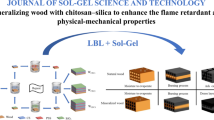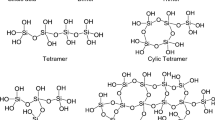Abstract
Employing a combination of a layer-by-layer self-assembly and sol gel methods, a negatively charged silica sol was successfully deposited into the cell wall and cell cavity of wood by the electrostatic attraction of cationic polyelectrolytes. The physical and mechanical properties, microscopic morphology and the chemical structure of the silica-mineralized wood were characterized using mechanical testing, scanning electron microscopy (SEM–EDS), Fourier-transform infrared spectroscopy and X-ray diffraction (XRD). The thermal performance of the treated wood was investigated using a cone calorimeter, thermogravimetry analysis (TG). SEM images and XRD results showed that the mineralization layer of the treated wood had various forms of amorphous nano-SiO2 particles, which could be attributed to multi-layers of polyelectrolytes. The mechanical strength of the mineralized wood was greatly improved. Based on the TG results, the major thermal degradation (mass loss at about 50%) began at higher temperatures for the silica-mineralized wood. Fire resistance testing demonstrated that the maximum heat release rate of the modified wood was less than that of the untreated wood, indicating that the silica mineralized layer had effectively altered the combustion mechanism. In addition, this work also considered the hydrophobic properties of silica-mineralized wood. In conclusion, the thermal stability and dimensional stability of silica-modified wood was insignificantly improved.










Similar content being viewed by others
References
Dong Y, Wang K, Yan Y, Zhang S, Li J. Grafting polyethylene glycol dicrylate (PEGDA) to cell walls of poplar wood in two steps for improving dimensional stability and durability of the wood polymer composite. Holzforschung. 2016;70:919–26.
Han X, Yin Y, Zhang Q, Li R, Pu J. Improved wood properties via two-step grafting with Itaconic acid (IA) and nano-SiO2. Holzforschung. 2018;72:499–506.
Avella M, Avolio R, Bonadies I, Carfagna C, Errico ME, Gentile G. Effect of compatibilization on thermal degradation kinetics of HDPE-based composites containing cellulose reinforcements. J Therm Anal Calorim. 2010;102:975–82.
Labe S, Gee CT, Ballhaus C, Nagel T. Experimental silicification of the tree fern dicksonia antarctica at high temperature with silica-enriched H2O vapor. Palaios. 2012;27:835–41.
George M. Wood petrifaction: a new view of permineralization and replacement. Geosciences. 2017;7:119.
Wang X, Deng Y, Li S, Wang G, Qin E, Xu X, et al. Biomineralization-based virus shell-engineering: towards neutralization escape and tropism expansion. Adv Healthc Mater. 2012;1:443–9.
Mao L-B, Gao H-L, Yao H-B, Liu L, Colfen H, Liu G, Yu S-H. Synthetic nacre by predesigned matrix-directed mineralization. Science. 2016;354:107–10.
Lee J, Choi J, Park JH, Kim M-H, Hong D, Cho H, Choi IS. Cytoprotective silica coating of individual mammalian cells through bioinspired silicification. Angew Chem. 2014;126:8194–7.
Atalay S, Ma Y, Qian S. Analytical model for charge properties of silica particles. J Colloid Interface Sci. 2014;425:128–30.
Delak KM, Sahai N. Amine-catalyzed biomimetic hydrolysis and condensation of organosilicate. Chem Mater. 2005;17:4272.
Decher G. Fuzzy nanoassemblies: toward layered polymeric multicomposites. Science. 1997;277:1232–7.
Lionetto F, Del Sole R, Cannoletta D, et al. Monitoring wood degradation during weathering by cellulose crystallinity. Materials. 2012;5:1910–22.
Chen HY, Lang Q, Bi Z, et al. Impregnation of poplar wood (Populus euramericana)with methylolurea and sodium silicate sol and induction of in situ gel polymerization by heating. Holzforschung. 2013;68:45–52.
Sanchez-Silva L, López-González D, Villaseñor J, Sánchez P, Valverde JL. Thermogravimetric-mass spectrometric analysis of lignocellulosic and marine biomass pyrolysis. Bioresour Technol. 2012;109:163–72.
Gai C, Dong Y, Zhang T. The kinetic analysis of the pyrolysis of agricultural residue under non-isothermal conditions. Bioresour Technol. 2013;127:298–305.
Hung K-C, Wu JH. Characteristics and thermal decomposition kinetics of wood-SiO2 composites derived by the sol-gel process. Holzforschung. 2016;71:233–40.
Hung K-C, Wu J-H. Comparison of physical and thermal properties of various wood-inorganic composites (WICs) derived by the sol-gel process. Holzforschung. 2018;72:379–86.
Wang T, Liu T, Ma T, Li L, Wang Q, Guo C. Study on degradation of phosphorus and nitrogen composite UV-cured flame retardant coating on wood surface. Prog Org Coat. 2018;124:240–8.
Alongi J, Ciobanu M, Malucelli G. Sol–gel treatments for enhancing flame retardancy and thermal stability of cotton fabrics: optimisation of the process and evaluation of the durability. Cellulose. 2010;18:167–77.
Feih S, Mathys Z, Mathys G, Gibson AG. Influence of water content on failure of phenolic composites in fire. Polym Degrad Stabil. 2008;93:376–82.
Shabir Mahr M, Hübert T, Schartel B, Bahr H, Sabel M, Militz H. Fire retardancy effects in single and double layered sol–gel derived TiO2 and SiO2-wood composites. J Sol-Gel Sci Technol. 2012;64:452–64.
Acknowledgements
This work was funded by the National Natural Science Foundation of China (31770606), Major Science and Technology Program of Hunan Province of China (2017NK1010) and Postgraduate Science and Technology Innovation Fund of Central South University of Forestry and Technology.
Author information
Authors and Affiliations
Contributions
YT and YG conceived and designed the experiments; XM, YT and CS carried out the laboratory experiments; YT, YG and MM analyzed the data, interpreted the results, prepared figures, and wrote the manuscript. All authors read and approved the final manuscript.
Corresponding author
Additional information
Publisher's Note
Springer Nature remains neutral with regard to jurisdictional claims in published maps and institutional affiliations.
Rights and permissions
About this article
Cite this article
Yang, T., Xia, M., Chen, S. et al. Enhancing the thermal stability of silica-mineralized wood via layer-by-layer self-assembly. J Therm Anal Calorim 145, 309–318 (2021). https://doi.org/10.1007/s10973-020-09786-6
Received:
Accepted:
Published:
Issue Date:
DOI: https://doi.org/10.1007/s10973-020-09786-6




